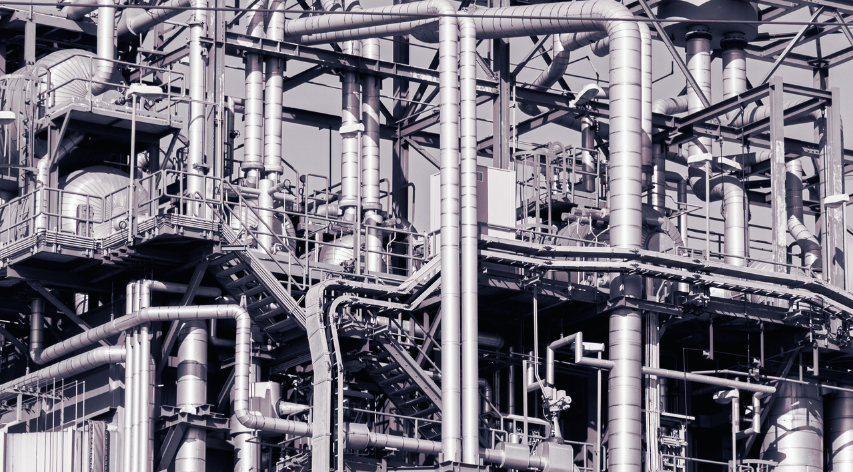Under Pressure
Hydroprocessing Heat Exchanger Fouling due to Di-olefin Polymerization
Over the past few months, I have received several questions about heat exchanger fouling in hydrotreaters due to polymerization of di-olefins and/or other gum precursors in the feed. I have seen plenty of heat exchangers foul in my career due to this mechanism and have found a few mitigation options that may help you.


Incidents related to Di-olefin Polymerization
Incident 1
Two naphtha hydrotreaters that feed coker naphtha in separate refineries experienced repeated episodes of heat exchanger fouling due to di-olefin polymerization. Di-olefin saturation reactors were installed in both units and the heat exchanger fouling was resolved. The saturation reactors also absorbed silicon in the feed, which allowed the main reactor to extend its catalyst runs.
Incident 2
A hydrotreater feeding coker heavy naphtha and diesel had operated successfully for over 30 years with little heat exchanger fouling nor reactor pressure drop problems. To prepare for lower sulfur gasoline requirements, the coker pentane/hexane stream was routed to the hydrotreater. The new stream made up about 15% of the feed to the unitand was routed directly to the reactor without passing through tankage while the other feed was routed through a tank that was blanketed with nitrogen.
Unfortunately, the unit began to experience severe heat exchanger fouling and a rapidly increasing reactor pressure drop. The unit was only able to run for 5-6 months before the reactor pressure drop exceeded the maximum limit. Prior to this time, the unit had run for as long as 5 years with little pressure drop increase.
The deposits in the heat exchangers and reactor inlet were “fluffy” rather than dense in nature. The volume of deposits filled up the reactor inlet shell on top of the catalyst surface and distribution trays. Antioxidant chemical was added to the product rundowns and solvency additive added to the hydrotreater feed with little improvement.
The unit experienced several short runs before the root cause of the deposits was identified. The biggest cause of the problem was the change of adding coker pentane/hexane to the feed, which resulted in more di-olefins in the feed and, more importantly, resulted in total vaporization of the feed in the feed/effluent exchangers. When the last bit of liquid vaporized, any polymers that had formed dropped out of solution. This deposition during boiling explained the “fluffy” nature of the deposits found both in the heat exchanger and the reactor.
Even with feed tank blanketing and chemical additives, some polymerization was occurring in the feed. After the deposits formed in the heat exchangers, most of the deposits would be carried into the reactor inlet.
To avoid total feed vaporization, light cycle oil (LCO) was routed to the unit. The LCO prevented full vaporization of the hydrocarbon liquid phase and provided an excellent solvent to keep the polymers in solution. After establishing and maintaining a minimum flow of LCO to the unit, the heat exchanger fouling, and reactor pressure drop problems were abated.
Incident 3
A hydrotreater processing a mix of coker jet and straight-run jet cuts experienced heat exchanger fouling and reactor pressure drop problems. Deposits in the exchangers and reactor inlet consisted mostly of carbon derived from di-olefin polymerization. In this unit, the feed/effluent exchangers were designed to run with oil only on the feed side (no hydrogen). The lack of hydrogen in the feed side of the exchangers caused low velocities and is believed to contribute to the fouling.
A study determined that hydrogen could not be added to the feed side of the exchangers due to inadequate metallurgy on the exchanger shells. The refinery decided to consider metallurgy upgrades for a future turnaround.
Antioxidant and solvency chemicals were added to the unit and the run length was adequately extended. The unit still required periodic heat exchanger cleaning and reactor skims, but the chemical additions were successful in prolonging the time between cleaning.
Lessons from Heat Exchanger Fouling Incidents
- All coker streams contain di-olefins, which can polymerize as the feed heats up above 350-450°F. Di-olefins are more concentrated in lighter boiling coker products such as coker penhex and coker naphtha but are still present in heavier streams such as coker diesel and coker gasoil.
- Preventing oxygen contact can help to reduce polymerization of di-olefins but may not eliminate it.
- It should be noted that many refineries experience polymerization even if the coker feed is processed through a blanketed feed tank. Often the source of oxygen comes from other streams that are mixed with a coker stock in the feed to a hydrotreater.
- Fully vaporizing feed streams will allow any polymers that form to drop out of solution and form deposits. It’s impossible to prevent coker naphtha from vaporizing, so it’s especially important to prevent polymerization in naphtha hydrotreating units through oxygen elimination and/or the use of chemical additives.
- The most effective method to prevent polymerization is by using a di-olefin saturation reactor to react di-olefins and olefins with hydrogen at mild conditions before they get hot enough to polymerize.
Di-olefin Saturation Reactor
As mentioned above, the best way to prevent heat exchanger fouling from di-olefin polymerization is to add a di-olefin saturation reactor to your unit. A saturation reactor is shown in the naphtha hydrotreater flow diagram below. The feed stream and hydrogen are routed through the di-olefin saturation reactor operating at about 400-450°F. The reactor contains hydrotreating catalyst that saturates the di-olefins with hydrogen before polymerization can occur.
A saturation reactor can also remove some silicon before the feed enters the main reactor. Very clever refiners often install two reactors that can be switched while the unit is on-line to prolong the catalyst life of the main reactor as well as prevent heat exchanger fouling.

Application in your unit(s)
If you are experiencing heat exchanger fouling while feeding coker stocks (or other stocks containing di-olefins):
- Do you prevent oxygen contact for all feeds to the unit including nitrogen blanketed feed tanks?
- Have you considered the use of oxygen scavenger in the feeds?
- Have you considered the use of solvency additives?
- Have you considered adding a di-olefin saturation reactor(s) to the unit?
As always, I welcome and appreciate feedback, questions, comments, and suggestions on this topic and other topics covered in our blogs.







